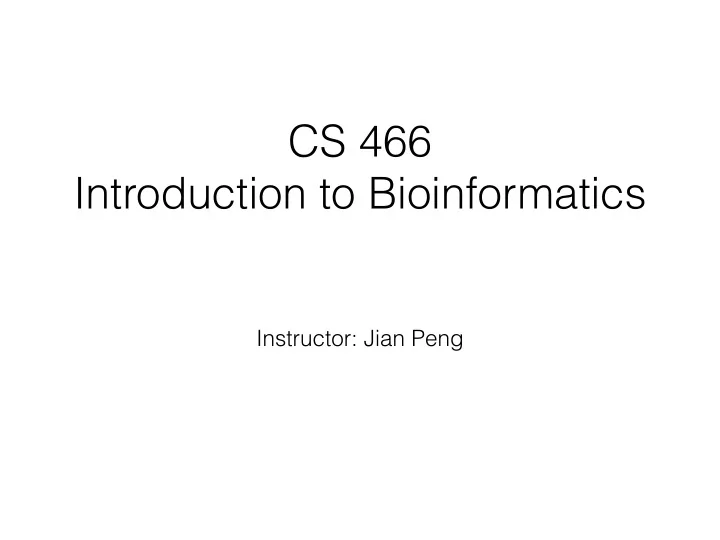

CS 466 Introduction to Bioinformatics Instructor: Jian Peng
Important Biological Questions? “Why do humans have so few genes?” “Can we understand DNA code?” “Can we understand gene function?” “How did cooperative behavior evolve?” “Can we cure cancer?” ……
Reading assignment Please read “Molecular Biology for Computer Scientists” by Lawrence Hunter
Heredity and DNA DNA discovered as the physical (molecular) carrier of hereditary information DNA is a molecule: deoxyribonucleic acid Double helical structure (discovered by Watson, Crick & Franklin) Chromosomes are densely coiled and packed DNA • DNA is a very “long” molecule • DNA in human has 3 billion base-pairs • String of 3 billion characters ! (about 6 feet long) • DNA harbors “genes” • A gene is a substring of the DNA string • A gene “codes” for a protein
DNA The$DNA$Molecule 5 � G -- C A -- T T -- A G -- C C -- G Base$pairing$property G -- C T -- A = G -- C T -- A T -- A A -- T A -- T C -- G T -- A 3 �
Base pairing
DNA to chromosome SOURCE:(http://www.microbe.org/espanol/news/human_genome.asp
What information does DNA encode?
What is RNA? RNA = ribonucleic acid • “U” instead of “T” • Usually single stranded • Has base-pairing capability • Can form simple non-linear structures • Life may have started with RNA
Transcription • Process of making a single stranded mRNA using double stranded DNA as template • Only genes are transcribed, not all DNA • Gene has a transcription “start site” and a transcription “stop site”
Translation • Process of making an amino acid sequence from (single stranded) mRNA • Each triplet of bases translates into one amino acid • Each such triplet is called “codon” • The translation is basically a table lookup
Protein sequence
Amino acids
Genetic code: lookup table
A short summary: string transformation • DNA = nucleotide sequence • Alphabet size = 4 (A,C,G,T) • DNA to mRNA (single stranded) • Alphabet size = 4 (A,C,G,U) • mRNA to amino acid sequence • Alphabet size = 20 • Amino acid sequence “folds” into 3-dimensional protein
Protein folding
Tertiary structure
Protein function Molecular switch Enzyme Signaling transduction
Protein domains kinase sh2 sh3
Gene structure One gene can be translated into multiple different proteins
Gene expression • Process of making a protein from a gene as template • Transcription, then translation • Can be regulated TRANSCRIPTION TRANSCRIPTION GENE FACTOR GENE FACTOR ACAGTGA PROTEIN
Gene regulation • Chromosomal activation/deactivation • Transcriptional regulation • Splicing regulation • mRNA degradation • mRNA transport regulation • Control of translation initiation • Post-translational modification That is a “circuit” responsible for controlling gene expression
Genome • The entire sequence of DNA in a cell • All cells have the same genome • All cells came from repeated duplications starting from initial cell (zygote) • Human genome is 99.9% identical among individuals • Human genome is 3 billion base-pairs (bp) long • Genes and regulatory sequences make up 5% of human genome • What’s the rest doing? • We don’t know for sure
Recommend
More recommend